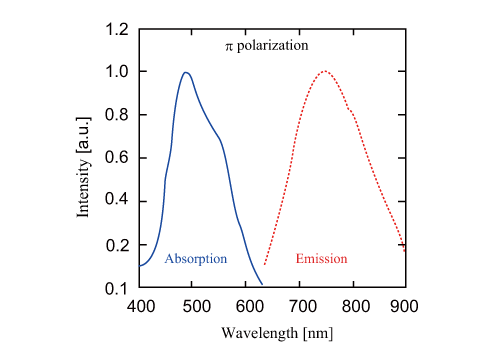Ti sapphire laser
Titanium (Ti) sapphire laser was first confirmed to oscillate in 1982 by P.F.Moulton. Titanium sapphire (Ti: Al2O3 :Ti:sapphire) crystal is a sapphire crystal (Al2O3) similar to the base material of ruby laser (Cr: Al2O3 laser), doped with Ti3+. Since Al2O3 has good thermal conductivity, it is suitable as a high repetition and high power laser. Due to these features, titanium sapphire laser has been widely used as an alternative to the Dye laser, and is widely used for femtosecond spectroscopy, nonlinear optics, white light generation, terahertz wave generation, and so on.
Figure 1 shows the absorption and fluorescence spectra of the titanium sapphire laser. As shown in the figure, the fluorescence spectrum of Ti: Al2O3 is very wide, so by inserting a wavelength selective element in the laser resonator, A wavelength tunable laser in the range of 1100nm is possible. Furthermore, it is possible to make ultra-short pulse up to a pulse width of 5.5fs by mode synchronization, and research is currently underway. The pulse width of the popular titanium sapphire laser is ~100fs, the repetition frequency is 70~80MHz, and the average output is ~2.5W.
On the other hand, the absorption spectrum is in the green region (peak is 488 nm), and the product of the fluorescence lifetime and the stimulated emission cross section is small. Therefore, laser oscillation requires strong excitation light with good beam quality. Therefore, there is no LD excitation, but laser excitation by the second harmonic (527 to 532 nm) of Argon ion laser (514 nm), Nd:YAG, Nd:YLF, and Nd:YVO4 laser. .. Since this causes the instability of the Ti: Sapphire laser, the method of directly exciting the LD is being investigated recently.
Infrared ultra-short pulse lasers that oscillate according to the same principle as titanium sapphire lasers are commercially available as Cr:Forsterite lasers using Cr:Forsterite crystals, and can be excited by InGaAlP LDs (670nm band) such as Cr:LiSAF. There is also a Cr:LiCAF racer.

図1:Ti: Absorption and fluorescence spectra of Al2O3
Mode-locked Ti sapphire laser
The most common configuration of mode-synchronized titanium (Ti) sapphire lasers is to utilize a nonlinear optical phenomenon called Kerr-Lens Mode locking (KLM) shown in Fig. 2 or self-mode synchronization. Like conventional solid-state lasers, pumping light enters the resonator and oscillates and amplifies the laser light. The high-intensity part of the light that has been amplified and becomes high-intensity is converged by the curence effect (increasing the light intensity or the refractive index at a higher position and becoming like the laser medium lens) induced in the laser medium. To do. The high-intensity part of the laser light is selected by the slit and becomes stable in the strong pulse-cavity resonator. This produces ultra-short pulses.
The pair of plasmas in the resonator are used to compensate for the broadening of the pulse due to the temporal Kerr effect that occurs in the laser medium. In some cases a chirp mirror is used instead of a pair of prisms. Recently, a mode synchronous laser using a semiconductor saturable absorber mirror (SESAM) instead of KLM has been introduced.

図2:
Car lens mode-locked titanium sapphire laser
